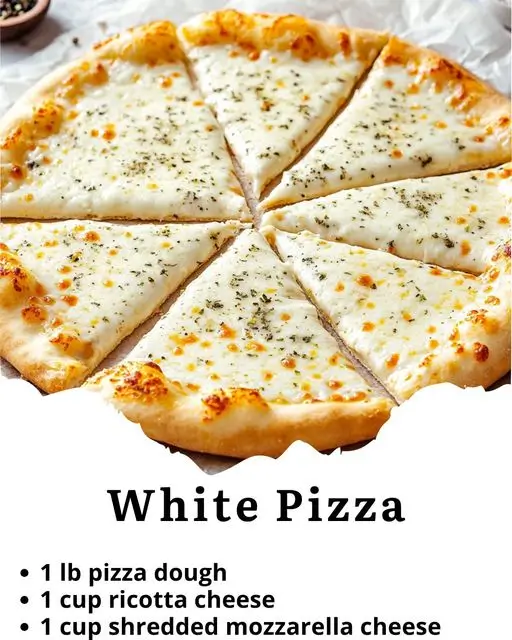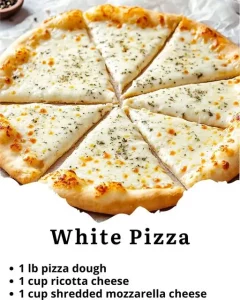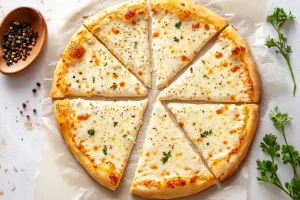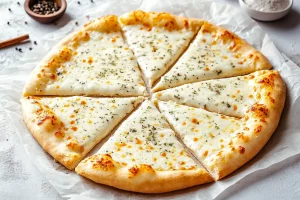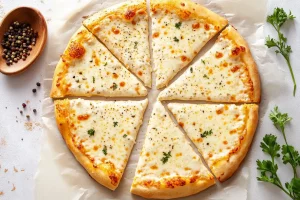Introduction to White Pizza
White pizza, also known as “pizza bianca,” is a delicious alternative to the traditional pizza that skips the tomato sauce in favor of a creamy, cheesy base. The unique flavor profile offers a lighter, yet indulgent taste that appeals to both pizza lovers and those seeking something different. The combination of rich cheeses, garlic, olive oil, and a variety of fresh toppings makes it a versatile dish that can be customized to suit any palate. This pizza stands out because it allows the other ingredients to shine without the bold presence of tomato sauce, making every bite flavorful yet subtle.
Print
White Pizza
- Total Time: 27 minutes
- Yield: 4 servings
- Diet: Vegetarian
Description
A delightful twist on traditional pizza, White Pizza (Pizza Bianca) ditches the tomato sauce for a rich, garlic-infused cheese base. Topped with a selection of cheeses and fresh ingredients, it’s a creamy, flavorful delight perfect for any cheese lover.
Ingredients
Instructions
Notes
For a crispy crust, bake on a preheated pizza stone or steel. Add toppings like spinach, mushrooms, or prosciutto after the pizza is baked for added freshness and texture.
- Prep Time: 15 minutes
- Cook Time: 12 minutes
- Category: Main Course
- Method: Baking
- Cuisine: Italian
Nutrition
- Calories: 400 per serving
- Sodium: 500mg
- Fat: 18g
- Carbohydrates: 40g
- Protein: 22g
FAQs about White Pizza
- What makes White Pizza different from other types of pizza? White Pizza is unique because it does not use tomato sauce; instead, it features a rich blend of cheeses and garlic, making it creamier and subtler in flavor.
- Can I add meat to my White Pizza? Absolutely! While White Pizza is delicious as a vegetarian option, you can add meats such as prosciutto or grilled chicken for extra flavor.
- Is White Pizza suitable for those with lactose intolerance? White Pizza is cheese-heavy, making it unsuitable for those with lactose intolerance unless lactose-free cheese substitutes are used.
- What kind of wine pairs well with White Pizza? A light, crisp white wine like Pinot Grigio or Chardonnay pairs beautifully with the creamy and rich flavors of White Pizza.
- Can I make White Pizza vegan? Yes, you can substitute the cheeses with vegan cheese alternatives and use vegan dough to make your White Pizza entirely plant-based.
The origins of white pizza can be traced back to Italy, where simplicity and high-quality ingredients define traditional cuisine. Over time, this minimalist approach to pizza has gained popularity worldwide, with various adaptations appearing in different regions. What makes white pizza unique is the use of different types of cheese, including mozzarella, ricotta, and Parmesan, which create a creamy, luscious base that contrasts beautifully with crispy, well-baked dough. This combination delivers a pizza that feels indulgent without being overly heavy.
Another reason why white pizza has become a favorite is its adaptability. Since the base is neutral in flavor, it allows for creativity when selecting toppings. Vegetables such as spinach, mushrooms, and arugula add fresh, vibrant notes, while meats like prosciutto or grilled chicken bring a savory richness. Herbs like rosemary and thyme, along with garlic and olive oil, add aromatic depth, enhancing the overall taste experience. This pizza invites experimentation, making it a popular choice for both home cooks and gourmet chefs alike.
The creamy base of white pizza also opens the door to various textures. The blend of soft cheeses contrasts with the crunch of a well-cooked crust, while any added toppings contribute their unique textures to the bite. Whether it’s the snap of fresh vegetables or the chew of melted cheese, each element plays a role in creating a harmonious and satisfying eating experience. This textural variety ensures that white pizza remains an interesting and appealing dish for those who love a mix of flavors and sensations in every bite.
White pizza is also celebrated for its versatility in pairings. Its lighter, more subtle flavors pair beautifully with a range of sides and drinks. Fresh salads, particularly those featuring peppery greens or tangy vinaigrettes, provide a refreshing counterpoint to the richness of the pizza. For beverages, a crisp white wine or even a cold craft beer complements the creamy and savory notes without overwhelming the palate. These pairing options make white pizza an excellent choice for various occasions, from casual dinners to more elaborate gatherings.
Key Ingredients of White Pizza
The primary ingredients of white pizza set it apart from traditional pizza and are crucial in creating its distinct taste. At the heart of white pizza is a cheese base, often made from a combination of mozzarella, ricotta, and Parmesan. These cheeses provide the creamy texture and mild flavors that make the pizza so versatile. Mozzarella delivers the classic stretchy, gooey texture that pizza lovers expect, while ricotta adds a soft, almost fluffy layer that enhances the pizza’s richness. Parmesan contributes a sharp, salty edge that balances the smoothness of the other cheeses.
Garlic is another essential component of white pizza, infusing it with a warm, aromatic flavor that pairs well with the cheeses. Typically, the garlic is minced and mixed with olive oil before being spread over the dough, which ensures the garlic flavor permeates each bite without being too overpowering. Olive oil itself plays a dual role: it acts as a carrier for the garlic and also helps create a golden, crispy crust. The quality of olive oil is key, as its flavor can subtly elevate the overall taste of the pizza.
Herbs and seasonings are what give white pizza its final layers of flavor. Fresh or dried rosemary, thyme, and oregano are popular choices, as they add an earthy, fragrant note that complements the richness of the cheese and garlic. Crushed red pepper flakes can be sprinkled on for a bit of heat, providing a nice contrast to the mild, creamy flavors. Salt and pepper are, of course, fundamental seasonings that bring out the best in each ingredient without overwhelming the delicate balance of flavors.
The crust is another crucial component that can elevate a white pizza. Whether it’s a thin, crispy crust or a thicker, chewier one, the dough serves as the foundation for all the toppings. A well-made crust should have enough structure to hold the rich toppings without becoming soggy, yet remain light and airy on the inside. Some recipes may call for brushing the crust with olive oil or even garlic butter before baking to add an extra layer of flavor and to help achieve a beautiful golden-brown finish.
Toppings on white pizza are where individual creativity can truly shine. Common vegetable choices include spinach, mushrooms, and arugula, all of which add fresh, slightly bitter notes that balance the creaminess of the cheese. Meats such as grilled chicken, pancetta, or prosciutto can bring savory depth, while seafood like shrimp or anchovies offers a briny, oceanic flavor. No matter the toppings, they should complement the base ingredients without overpowering the delicate balance of flavors that white pizza is known for.
Cooking Techniques for White Pizza
When making white pizza, the cooking technique plays an integral role in achieving the perfect balance of a crispy crust and a melty, creamy topping. A hot oven is key to this balance, as the high temperature allows the crust to cook quickly while ensuring the cheese melts evenly without becoming too greasy. Preheating the oven to a temperature of around 500°F (260°C) is a common practice, as it mimics the effect of a traditional pizza oven, which cooks pizza rapidly at high heat.
Using a pizza stone or baking steel is another method that can elevate the quality of a homemade white pizza. These tools help evenly distribute the heat, resulting in a crust that is crispy on the outside but tender and airy on the inside. Placing the pizza directly onto a preheated stone or steel ensures that the dough gets the intense heat it needs to develop a crunchy exterior without drying out. This method is especially useful for those seeking the professional-quality texture that one might find in a pizzeria.
For the cheese to melt perfectly and develop a slight golden color, it’s important to pay attention to the balance of ingredients. Too much cheese can weigh down the dough and make the pizza soggy, while too little can result in a dry texture. A thin, even layer of mozzarella, followed by dollops of ricotta and a sprinkle of Parmesan, is the standard approach. This layering ensures that each cheese melts and browns at different rates, creating a complex texture and flavor profile as the pizza bakes.
When it comes to adding toppings, timing is crucial. More delicate toppings, such as arugula or fresh herbs, are best added after the pizza comes out of the oven to maintain their freshness and vibrant flavor. Heartier ingredients like mushrooms or meats can be added before baking, as the heat helps bring out their natural flavors and textures. A drizzle of olive oil or a sprinkle of sea salt after baking can also add a final touch of richness and enhance the overall taste experience.
Finally, letting the pizza rest for a few minutes after it comes out of the oven is an often-overlooked but important step. Allowing the pizza to cool slightly before slicing helps the cheese set, making it easier to cut and serve. This also prevents the toppings from sliding off, ensuring that each slice maintains the perfect ratio of crust, cheese, and toppings. By paying attention to these cooking techniques, home cooks can achieve a white pizza that rivals even the best pizzerias.
Pairing Suggestions for White Pizza
Pairing white pizza with the right sides and beverages can enhance the dining experience, allowing its flavors to shine even more. Because white pizza is generally lighter and less acidic than traditional tomato-based pizzas, it pairs well with fresh, crisp sides. A simple arugula salad dressed with lemon and olive oil is an excellent complement to the richness of the cheese. The peppery arugula and the acidity of the lemon provide a refreshing contrast to the creamy pizza, creating a well-balanced meal.
In terms of beverages, white pizza goes exceptionally well with white wines, especially those that are light and crisp. A Pinot Grigio or Sauvignon Blanc offers citrus and herbal notes that balance the creaminess of the pizza without overwhelming the palate. For those who prefer beer, a light lager or a wheat beer with hints of citrus can provide a refreshing complement to the rich, cheesy flavors. These beverages cleanse the palate, allowing each bite to feel as fresh as the first.
For a heartier pairing, roasted vegetables like asparagus, zucchini, or bell peppers can add another dimension to the meal. The caramelized sweetness of the roasted vegetables contrasts nicely with the mild cheese and garlic, while the smoky notes add depth. These vegetables can either be served as a side dish or added as a topping on the pizza itself for an extra burst of flavor. This combination of textures and tastes ensures a fulfilling and satisfying dining experience.
For those looking to serve white pizza at a gathering, consider offering a variety of dips alongside it. Garlic aioli, pesto, or even a spicy marinara on the side can allow guests to customize their slices to their liking. These sauces add an additional layer of flavor, allowing the pizza to be both a sophisticated meal and a versatile party dish. By providing different pairing options, white pizza can be adapted to suit different tastes and occasions.
Lastly, for dessert, something light and refreshing can serve as the perfect ending to a white pizza meal. A lemon sorbet or a fruit salad with mint leaves can cleanse the palate and provide a sweet, tangy contrast to the rich flavors of the pizza. The balance of creamy, savory pizza followed by a light and zesty dessert creates a satisfying and complete dining experience, making white pizza a versatile and elegant choice for any meal.
Conclusion
White Pizza offers a delicious and versatile alternative to traditional pizza, allowing the rich flavors of cheese, garlic, and fresh herbs to take center stage. Its creamy, indulgent texture paired with a crispy crust makes it a favorite for both casual meals and special gatherings. The simplicity of its ingredients allows for endless customization, whether you’re adding fresh vegetables, savory meats, or keeping it classic with just cheese. With the right technique, ingredients, and a little creativity, White Pizza can easily become a go-to dish for pizza lovers seeking something a little different, yet equally satisfying.

